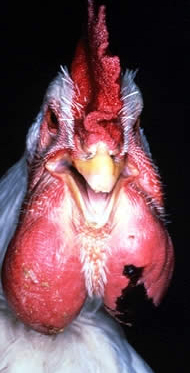



Rapid Differentiation of Pasteurella multocida Serovars
Australian researchers have developed a more accurate and rapid diagnostic tool to type serovars of the pathogen that causes fowl cholera.
Dr John Boyce and Dr Marina Harper at Monash University, together with Dr Conny Turni from the QLD Alliance for Agriculture and Food Innovation (QAFFI), are undertaking a Poultry CRC project that has developed an accurate and rapid diagnostic tool for typing serovars of Pasteurella multocida, the causative agent of fowl cholera. This new technique, which differentiates strains on the basis of their lipopolysaccharide (LPS) biosynthesis genes, is far more accurate than previous ‘Heddleston’ serotyping.
Strains belonging to the heterogeneous P. multocida species are classically differentiated in five serogroups (A, B, D, E and F), and further serotyped into 16 serovars (1-16) based on LPS antigens using the Heddleston typing scheme. This project set out to replace the Heddleston serotyping with a more accurate and reliable multiplex polymerase chain reaction (mPCR) assay.
Team leader, John Boyce, explains, “We are confident that our mPCR can differentiate P. multocida strains accurately (around 98 per cent) on the basis of their LPS biosynthesis genes. Our data also show that the Heddleston serological typing, which our mPCR will replace, is accurate only 34 per cent of the time.”
As well as typing serovars faster and more accurately, the development of this technique represents a significant improvement in reproducibility, which according to Dr Boyce is, “greater than 95 per cent for mPCR while serology resides below 70 per cent. The mPCR uses an easily generated set of 16 oligonucleotides, while Heddleston serology requires type-specific antisera which must be generated in chickens, and these antisera are particularly biologically variable. Serology takes at least 24 hours to generate a result while the mPCR can be completed in a few hours,” he said.

(Source: The Merck Veterinary Manual)
The second part of his project seeks to determine whether the classification of strains, based on LPS-specific genotypes (as determined by the mPCR), is predictive of the protective efficacy of killed and/or live attenuated vaccine strains.
Dr Boyce explained: “We know that our PCR can type P. multocida strains into eight different genotypes (or groups) based on differences in their LPS genes, but some strains within each genotype produce shorter LPS molecules due to mutations. Nobody knows if a vaccine containing bacteria producing full-length LPS will protect against strains producing the shorter versions. So we are trying to work that out by vaccinating chickens with strains producing different lengths of the same LPS structure then testing to see which birds are protected against disease.”
Poultry producers want to know which P. multocida types are present in their flock, and causing disease, so they are able to determine which vaccine to use to protect against further outbreaks.
“Having a complete understanding of the LPS structures and the antibodies generated against the LPS will lead to more effective vaccine formulations,” said Dr Boyce.
Development of the mPCR in this project represents a major step forward in the diagnostic capabilities for the Australian poultry industry, and rapid delivery of the outcomes of CRC research into practical reality for industry.
The multiplex PCR primers and prototype method will be transferred to Drs Conny Turni and Pat Blackall for incorporation into their typing service undertaken at the Microbiology Research Group, QAFFI, University of Queensland, Ecosciences Precinct, Dutton Park.
June 2013








